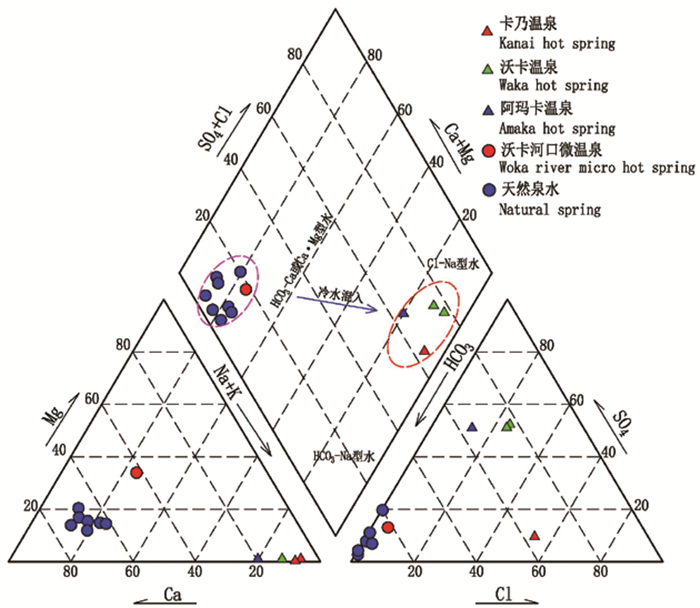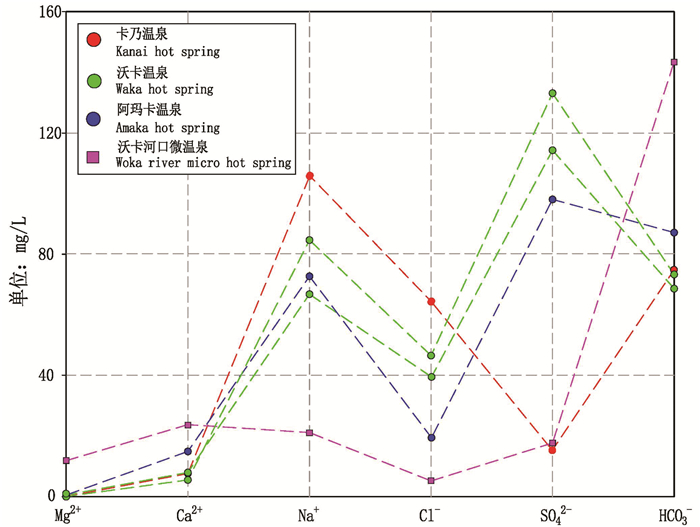Hydrogeochemical characteristics and genetic model of Oiga Graben geothermal waters system in Xizang
-
摘要:
通过沃卡地堑盆地地下热水水文地球化学特征研究,进行热储温度、补给高程计算,建立沃卡地堑地下热水系统中-高温地热概念模型。结果表明,沃卡温泉为中偏碱性水,溶解性总固体较低,水化学类型主要为SO4-Na型、SO4·Cl-Na型、HCO3·SO4-Na型。热水水文地球化学特征表明,沃卡盆地地下热水系统具有大气降水补给、浅循环地下水的特征,热水以深部熔融体为热源,受控于沃卡半隐伏控热断裂构造,但受裂隙潜水或地表冷水的混合作用,其Na-K-Mg平衡图表现为部分平衡或混合水。利用混合模型对热储真实温度进行估算,得到热储的温度范围为120~200℃,冷水混入比例为70%~83%。
Abstract:Based on the study of hot water hydrogeochemical characteristics of the Oiga Graben Geothermal Waters, the authors carried out hot water heat storage temperature and recharge elevation calculation, and established the Oiga Thermal Spring mediumhigh temperature geothermal concept model. The results show that the Oiga hot spring is of medium-alkaline water with low TDS, and the water chemical types are mainly SO4-Na type, SO4-Cl-Na type and HCO3- SO4-Na type. The hydrogeochemical characteristics of hot water indicate that the Oiga Springs are characterized by atmospheric rainfall recharge and shallow circulation groundwater in shallow geothermal systems. The hot water is heated by deep melting body and controlled by the Oiga semiinvisible controlled thermal fracture structure. but it is partially balanced or mixed with water in the Na-K-Mg triangle diagram due to the mixing effect by fissure diving or surface cold water. The mixed model is used to estimate the temperature before the influence of hot water and cold water mixing, the temperature range of the heat storage is 120-200℃, and the cold water mixing ratio is 70%-83%.
-
Key words:
- Oiga hot spring /
- hydrogeochemistry /
- formation mechanism /
- Cona-Oiga rift /
- Oiga Graben /
- hydrogeological survey engineering /
- Xizang
-

-
图 7 错那−墨竹工卡剖面电阻率模型(据谭捍东等, 2004, 2006修改)
Figure 7.
表 1 地下热水出露特征
Table 1. Exposure features of underground hot water

表 2 沃卡地堑出露温泉水文地球化学成果
Table 2. Hydrogeochemical results of Oiga Graben hot spring
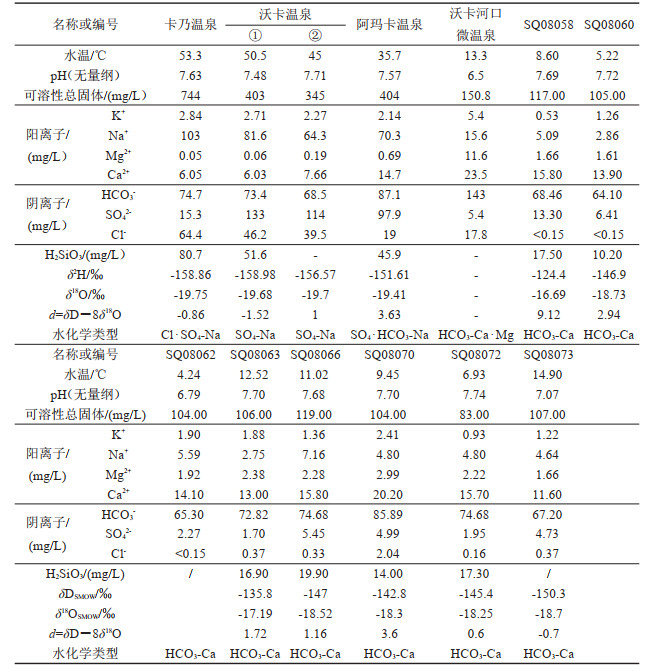
表 3 地下热水饱和指数模拟结果
Table 3. Simulation results in the saturation index of underground hot water
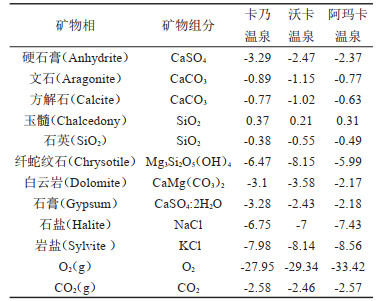
表 4 运用地球化学温标计算的热储温度值
Table 4. The temperature of thermal storage calculated by geochemical temperature scale

表 5 热水温度、焓以及SiO2质量浓度关系
Table 5. Relationship of water temperature, enthalpy and mass concentration of SiO2
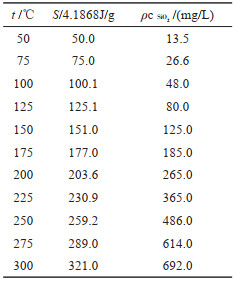
表 6 沃卡地堑盆地地下热水补给高程
Table 6. Supply elevation of underground hot water
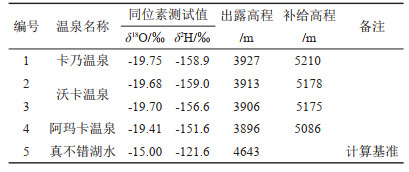
-
An Keshi, Zhang Xigen, He Shichun.1980. Geochemical characteristics of the Yangbajing geothermal field[J]. Hydrogeology & Engineering Geology, (1):14-18(in Chinese with English abstract).
Duo Ji.2003. The Basic characteristics of the Yangbajing geothermal field-A typical high temperature geothermal system[J]. Engineering Sciences, 5(1):42-47(in Chinese with English abstract). http://en.cnki.com.cn/Article_en/CJFDTOTAL-GCKX200301007.htm
Gan Cheng. 1980.Active faults and structures in Xizang, China[J]. Geology and Geochemistry, (3):46-52(in Chinese with English abstract).
Guo Qinghai, Wang Yanxin, Liu Wei.2007. Major hydrogeochemical processes in the two reservoirs of the Yangbajing geothermal field, Xizang, China[J]. Journal of Volcanology and Geothermal Research, 166(3):255-268. http://www.sciencedirect.com/science/article/pii/S0377027307002569
Guo Qinghai, Wang Yanxin, Liu Wei.2009 Hydrogeochemistry and environmental impact of geothermal waters from Yangyi of Xizang, China[J]. Journal of volcanology and geothermal research, 180(1):9-20. http://www.sciencedirect.com/science/article/pii/S0377027308006343
He Rizheng, Gao Rui. 2003. Some significances of studying northsouthern rift in Xizang plateau[J]. Progress in Geophysics, (1):35-43(in Chinese with English abstract). http://en.cnki.com.cn/Article_en/CJFDTOTAL-DQWJ200301006.htm
He Yongmei, Xun Xiaohui, Xie Ye. 2016. Formed causes and Hydrogeochemistry characteristics of hot springs in Xizang Voca[J].Journal of Geological Hazards and Environment Preservation, 27(4):66-70(in Chinese with English abstract). http://en.cnki.com.cn/Article_en/CJFDTOTAL-DZHB201604012.htm
Huang Guangshou, Guo Lili, Huang Kai.2020. Geothermal geological characteristics of five tectonic units in the sedimentary basins of Henan Province[J]. Geology and Resources, 29(02):172-179(in Chinese with English abstract)
Li Mingli, Duo Ji, Wang Zhu, Wu Guodong, Jiang Zhenzhen, Liu Gaoling.2015. Hydrochemical characteristics and material sources of the Riduo thermal springs in Xizang[J]. Carsologica Sinica, 34(03):209-216(in Chinese with English abstract). http://en.cnki.com.cn/Article_en/CJFDTotal-ZGYR201503002.htm
Liu Jian, Shi Jie, Yao Xin, Li Qin, Chang Zhiyong.2018. The control of neo-tectonic activity over geothermal resource in the Taxkorgan Basin on the northeastern margin of the Pamir[J]. Geology in China, 45(4):681-692(in Chinese with English abstract). http://en.cnki.com.cn/Article_en/CJFDTotal-DIZI201804004.htm
Liu Zhao. 2014. The Forming Mechanism of Typical Hightemperature Geothermal Systems in Nimu-Naqu Geothermal Belt, Xizang[D]. Shijiazhuang: Chinese Academy of Geologecal Sciences(in Chinese with English abstract).
Shen Licheng, Wu Kunyu, Xiao Qiong, Yuan Daoxian.2011. Carbon dioxide degassing flux from two geothermal fields in Xizang, China[J]. Chinese Science Bulletin, 56(26):2198-2208(in Chinese with English abstract). http://www.ixueshu.com/document/0c25ea62490640e5769c87af2e29694c318947a18e7f9386.html
Shen Xianjie, Wang Zirui.1984. Thermal reservoir model analysis of the Yangbajing geothermal field, XiZang Autonomous Region[J]. Scientia Sinica:Series B, 27(12):1316-1329. http://www.cnki.com.cn/Article/CJFDTotal-JBXG198412010.htm
Shen Xianjie, Zhang Wenren, Yang Shuzhen, Guan Ye, Jin Xu.1990.Heat flow evidence for the differentiated Crust-Mantle thermal structures of the northern and southern terranes of the QinghaiXizang plateau[J]. Journal of the Chinese Academy of Geological Sciences, (2):203-214(in Chinese with English abstract). http://en.cnki.com.cn/Article_en/CJFDTOTAL-DQXB199002019.htm
Song Meiyu, Liu Jie, Qin Lihong, Yu Yan.2018. Analysis on the hydrochemical characteristics and isotope of geothermal fluid in Tianjin[J]. Geological Survey and Research, 41(2):138-144(in Chinese with English abstract). http://en.cnki.com.cn/Article_en/CJFDTotal-QHWJ201802010.htm
Song Kai. 2012. Formed conditions of hot springs in Xizang Voca and Impact Studies on the Tunnel Project[D]. Chengdu: Chengdu University of Technology(in Chinese with English abstract).
Tan Handong, Jiang Mei, Wu Liangshi, Wei Wenbo. 2006. Electrical conductivity structure of the Qinghai-Xizang Plateau and its significance for the study of the lithosphere[J]. Geology in China, (04):906-911(in Chinese with English abstract). http://www.researchgate.net/publication/285535637_Electrical_conductivity_structure_of_the_Qinghai-Tibet_Plateau_and_its_significance_for_the_study_of_the_lithosphere
Tan Handong, Wei Wenbo, Martyn Unsworth, Deng Ming, Jin Sheng, John Booker, Alan Jones.2004. Study on the crustal electrical structure of the Yarlung Zangbo Suture Zone in the southern Xizang Plateau[J]. Chinese Journal of Geophysics, 2004, 33(4):685-690(in Chinese with English abstract). http://onlinelibrary.wiley.com/doi/10.1002/cjg2.3549/abstract
Tong Wei, Liao Zhijie, Liu Shibing Zhang Zhifei, You Maozheng, Zhang Mingtao. 2000.Hot Springs in Xizang[M]. Beijing:Science Press, 200-202.
Tong Wei, Zhang Mintao, Zhang Zhifei. 1981. Geothermal in Xizang[M]. Beijing:Science Press, 88-94.
Tong Wei, Zhang Zhifei, Zhang Mintao, Liao Zhijie, You Maozheng, Zhu Meixiang, Guo Guoyin, Liu Shibin.1978. The himalayan geothermal belt[J]. Acta Scientiarum Naturalium Universitatis Pekinensis, 1:76-89(in Chinese with English abstract).
Wang Guiling, Zhang Wei, Lin Wenjing, Liu Feng, Zhu Xi, Liu Yanguang, Li jun.2017. Research on formation mode and development potential of geothermal resources in Beijing-TianjinHebei region[J]. Geology in China, 44(6):1074-1085(in Chinese with English abstract). http://www.researchgate.net/publication/324014114_Research_on_formation_mode_and_development_potential_of_geothermal_resources_in_Beijing-Tianjin-Hebei_region
Wang Peng, Chen Xiaohong, Shen Licheng, Xiao Qiong, Wu Xiaoqing. 2016. Reservoir temperature of geothermal anomaly area and its environmental effect in Xizang[J].Geology in China, 43(4):1429-1438(in Chinese with English abstract). http://www.researchgate.net/publication/316544485_Reservoir_temperature_of_geothermal_anomaly_area_and_its_environmental_effect_in_Tibet
Wang Siqi. 2017. Hydrogeochemical Processes and Genesis Machenism of High-temperature Geothermal System in Gudui, Xizang[D]. Beijing: China University of Geoscience.
Wang Zhunbo, Shen Licheng, Liang Zuobing, Jiang Zeli, Liao Yu.2015. Characteristics of hydrochemical composition and stable carbon isotope of natural water in the Daggyia geothermal field, Xizang, China[J]. Carsologica Sinica, 34(3):201-208(in Chinese with English abstract). http://www.cqvip.com/QK/95841X/201503/665729009.html
Wei Siyu, Teng Jiwen, Yang Bingping, Hu Zhongyi. 1981.Characteristics of geothermal distribution and geophysical field of in Xizang Plateau[J]. Northwestern Seismological Journal, (4):17-25(in Chinese with English abstract).
Wu Zhonghai, Zhang Yongshuang, Hu Daogong, Zhao Xitao, Ye Peisheng. 2007. Quaternary normal faulting and its dynamics of the Oiga Graben in South-Eastern Xizang[J]. Acea Geologica Sinica, 81(10):1328-1339(in Chinese with English abstract). http://en.cnki.com.cn/Article_en/CJFDTOTAL-DZXE200710004.htm
Wu Zhonghai, Zhang Yongshuang, Hu Daogong, Zhao Xitao, Ye Peisheng. 2008. Late Cenozoic normal faulting of the Qungdo Gyang Graben in the Central Segment of the Cona-OIGA rift, Southeastern Xizang[J]. Journal of Geomechanics, 30(1):144-161(in Chinese with English abstract). http://en.cnki.com.cn/Article_en/CJFDTotal-DZLX200704003.htm
Xu Peng, Tan Hongbing, Zhang Yanfei, Zhang Wenjie.2018.Geochemical characteristics and source mechanism of geothermal water in Tethys Himalaya belt[J]. Geology in China, 45(6):1142-1154(in Chinese with English abstract). http://www.researchgate.net/publication/332712018_Geochemical_characteristics_and_source_mechanism_of_geothermal_water_in_Tethys_Himalaya_belt
Zhang Fengshu, Hou Lifeng, Zhong Dong.2008. Exploration and Evaluation Report on Groundwater Resources in Sangri County, the Yarlung Zangbo, Lhasa River, and Nyang Rivervalleys Basin Arid County of Xizang[R]. 915 Hydrogeology and Engineering Geology Company, Sichuan Geological & Mineral Bureau.
Zhang Meng, Lin Wenjing, Liu Zhao, Liu Zhiming, Hu Xiancai, Wang Guiling.2014. Hydrogeochemical characteristics and genetic model of Gulu high-temperature geothermal system in Xizang, China[J]. Journal of Chengdu University of Technology (Nature Sciences), (03):382-382(in Chinese with English abstract). http://en.cnki.com.cn/Article_en/CJFDTotal-CDLG201403015.htm
Zhang Senqi, Yan Weide, Li Dunpeng, Jia Xiaofeng, Zhang Shengsheng, Li Shengtao, Fu Lei, Wu Haidong, Zeng Zhaofa, Li Zhiwei, Mu Jianqiang, Cheng Zhengpu, Hu Lisha.2018. Characteristics of geothermal geology of the Qiabuqia HDR in Gonghe Basin, Qinghai Province[J]. Geology in China, 45(6):1087-1102(in Chinese with English abstract). http://www.researchgate.net/publication/332711709_Characteristics_of_geothermal_geology_of_the_Qiabuqia_HDR_in_Gonghe_Basin_Qinghai_Province
Zhao Ping, Jin Jian, Zhang Haizheng.1998. Chemical composi-tion of the ermal water in the Yangbajing geothermal field, Xizang[J]. Chinese Journal of Geology, 33(1):61-72(in Chinese with English abstract). http://www.researchgate.net/publication/284979897_Chemical_composition_of_thermal_water_in_the_Yangbajing_geothermal_field_TibetJ
Zhou Xun, Jin Xiaomei, Liang Sihai, Shen Ye, Zhang Hongmei.2017.Monograph on Groundwater Science (The second edition and the color version)[M]. Beijing:Geological Publishing House, 65-72.
安可士, 张锡根, 何世春.1980.羊八井地热田地球化学特征[J].水文地质工程地质, (1):14-18. http://www.cnki.com.cn/Article/CJFDTotal-SWDG198001004.htm
多吉. 2003.典型高温地热系统——羊八井热田基本特征[J].中国工程科学, 5(1):42-47. http://www.wanfangdata.com.cn/details/detail.do?_type=perio&id=zggckx200301008
干成. 1980.中国西藏的活动断层和构造[J].地质地球化学, (3):46-52. http://www.cnki.com.cn/Article/CJFDTotal-DZDQ198003004.htm
贺日政, 高锐.2003.西藏高原南北向裂谷研究意义[J].地球物理学进展, (1):35-43. http://www.ixueshu.com/document/c2ce2a60dbe1de5d2960c5329d874fc1318947a18e7f9386.html
贺咏梅, 荀晓慧, 谢晔.2016.西藏沃卡温泉水文地球化学特征及成因[J].地质灾害与环境保护, 27(4):66-70. http://www.cnki.com.cn/Article/CJFDTotal-DZHB201604012.htm
黄光寿, 郭丽丽, 黄凯.2020.河南省沉积盆地区五大构造单元地热地质特征[J].地质与资源, 29(02):172-179. http://www.cnki.com.cn/Article/CJFDTotal-GJSD202002009.htm
李明礼, 多吉, 王祝, 邬国栋, 姜贞贞, 刘高令.2014.西藏日多温泉水化学特征及其物质来源[J].中国岩溶, 34(3):209-216.
刘健, 史杰, 姚鑫, 李钦, 常志勇.2018.帕米尔高原东北缘活动构造对塔什库尔干盆地地热控制作用[J].中国地质, 45(4):681-692. http://geochina.cgs.gov.cn/geochina/ch/reader/view_abstract.aspx?file_no=20180403&flag=1
刘昭.2014.西藏尼木-那曲地热带典型高温地热系统形成机理研究[D].石家庄: 中国地质科学院.
沈立成, 伍坤宇, 肖琼, 袁道先.2011.西藏地热异常区CO2脱气研究:以朗久和搭格架地热区为例[J].科学通报, 56(26):2198-2208. http://www.cqvip.com/QK/94252X/201126/39404159.html
沈显杰, 张文仁, 杨淑贞, 管烨, 金旭.1990.青藏高原南北地体壳幔热结构差异的大地热流证据[J].中国地质科学院院报, (2):203-214. http://www.cnki.com.cn/Article/CJFDTotal-DQXB199002019.htm
宋美钰, 刘杰, 秦莉红, 于彦.2018.天津地热流体水化学特征及同位素分析[J].地质调查与研究, 41(02):138-144. http://www.cqvip.com/QK/92480B/20182/7000697069.html
宋凯.2012.西藏沃卡温泉形成条件及对隧道工程影响研究[D].成都: 成都理工大学, 2012.
谭捍东, 姜枚, 吴良士, 魏文博.2006.青藏高原电性结构及其对岩石圈研究的意义[J].中国地质, 33(04):906-911. http://geochina.cgs.gov.cn/geochina/ch/reader/view_abstract.aspx?file_no=20060420&flag=1
谭捍东, 魏文博, Martyn Unsworth, 邓明, 金胜, John Booker, Alan Jones.2004.西藏高原南部雅鲁藏布江缝合带地区地壳电性结构研究[J].地球物理学报, (4):685-690. http://www.wanfangdata.com.cn/details/detail.do?_type=perio&id=dqwlxb200404020
佟伟, 廖志杰, 刘时彬, 张知非, 由懋正, 章铭陶等.2000.西藏温泉志[M].北京:科学出版社, 200-202.
佟伟, 张知非, 章铭陶, 廖志杰, 由懋正, 朱梅湘, 国帼颖, 刘时彬.1978.喜马拉雅地热带[J].北京大学学报(自然科学版), (1):76-89. http://www.cnki.com.cn/Article/CJFD1979-BJDZ197801004.htm
佟伟, 章铭陶, 张知非.1981.西藏地热[M].北京:科学出版社, 88-94.
王贵玲, 张薇, 蔺文静, 刘峰, 朱喜, 刘彦广, 李郡.2017.京津冀地区地热资源成藏模式与潜力研究[J].中国地质, 44(6):1074-1085. http://geochina.cgs.gov.cn/geochina/ch/reader/view_abstract.aspx?file_no=20170603&flag=1
王鹏, 陈晓宏, 沈立成, 肖琼, 吴孝情.2016.西藏地热异常区热储温度及其地质环境效应[J].中国地质, 43(4):1429-1438. http://geochina.cgs.gov.cn/geochina/ch/reader/view_abstract.aspx?file_no=20160426&flag=1
王思琪.2017.西藏古堆高温地热系统水文地球化学过程与形成机理[D].北京: 中国地质大学.
王尊波, 沈立成, 梁作兵, 江泽利, 廖昱.2015.西藏搭格架地热区天然水的水化学组成与稳定碳同位素特征[J].中国岩溶, 34(3):201-208. http://www.cqvip.com/QK/95841X/201503/665729009.html
魏斯禹, 腾吉文, 杨秉平, 胡忠义.1981.西藏高原地热活动, 温泉分布与地球物理场特征[J].西北地震学报, (4):17-25. http://www.cnki.com.cn/Article/CJFDTotal-ZBDZ198104002.htm
吴中海, 张永双, 胡道功, 赵希涛, 叶培盛等.2008.藏南错那-沃卡裂谷的第四纪正断层作用及其特征[J].地震地质, 30(1):144-161. http://www.cqvip.com/Main/Detail.aspx?id=27055497
吴中海, 张永双, 胡道功, 赵希涛, 叶培盛.2007.西藏桑日县沃卡地堑的第四纪正断层活动及其机制探讨[J].地质学报, 81(10):1328-1339. http://d.wanfangdata.com.cn/Periodical/dizhixb200710003
许鹏, 谭红兵, 张燕飞, 张文杰.2018.特提斯喜马拉雅带地热水化学特征与物源机制[J].中国地质, 45(6):1142-1154. http://geochina.cgs.gov.cn/geochina/ch/reader/view_abstract.aspx?file_no=20180605&flag=1
张丰述, 侯利锋, 钟东.2008.西藏"一江两河"地区干旱县桑日县地下水资源勘查评价报告[R].眉山: 四川省地质矿产勘查开发局九一五水文地质工程地质队.
张萌, 蔺文静, 刘昭, 刘志明, 胡先才, 王贵玲.2014.西藏谷露高温地热系统水文地球化学特征及成因模式[J].成都理工大学学报(自然科学版), (3):382-392. http://www.cnki.com.cn/Article/CJFDTotal-CDLG201403015.htm
张森琦, 严维德, 黎敦朋, 贾小丰, 张盛生, 李胜涛, 付雷, 吴海东, 曾昭发, 李志伟, 穆建强, 程正璞, 胡丽莎.2018.青海省共和县恰卜恰干热岩体地热地质特征[J].中国地质, 45(6):1087-1102. http://geochina.cgs.gov.cn/geochina/ch/reader/view_abstract.aspx?file_no=20180601&flag=1
赵平, 金建, 张海政.1998.西藏羊八井地热田热水的化学组成[J].地质科学, 33(1):61-72. http://qikan.cqvip.com/Qikan/Article/Detail?id=2900858
周训, 金晓媚, 梁四海, 沈晔, 张红梅.2017.地下水科学专论(第2版彩色版)[M].北京:地质出版社, 65-72.
-



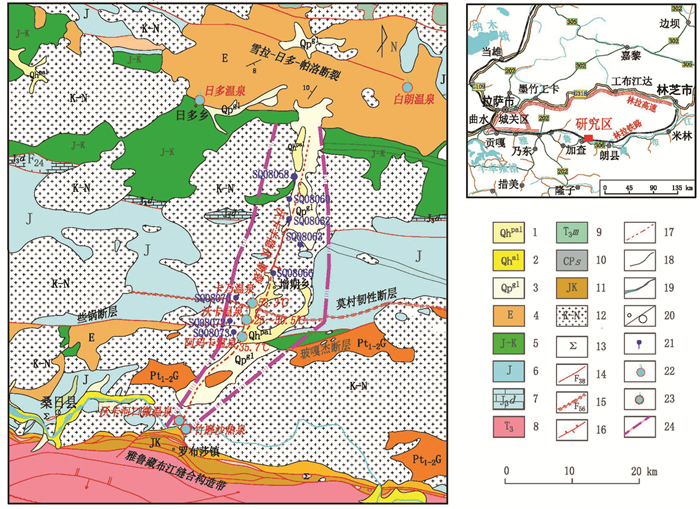
 下载:
下载:
